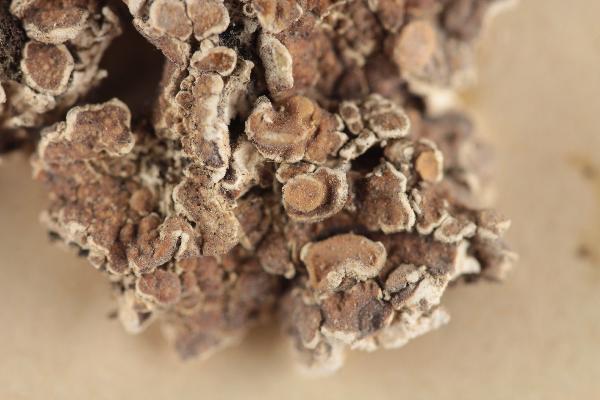Squamarina gypsacea (Sm.) Poelt
Mitt. bot. Staatss. München, 2: 539, 1958. Basionym: Lichen gypsaceus Sm. - Trans. Linn. Soc. London, 1: 81, 1791.
Synonyms: Lecanora crassa var. gypsacea (Sm.) Rabenh.; Lecanora fragilis Zahlbr. var. fragilis; Lecanora gypsacea (Sm.) Müll. Arg.; Lecanora smithii (Ach.) Ach.; Placodium gypsaceum (Sm.) Trevis.; Psoroma gypsaceum (Sm.) A. Massal.; Squamaria gypsacea (Sm.) Nyl.
Distribution: N - VG, Frl, Ven, TAA, Lomb, Piem, Emil (Tretiach & al. 2008, Fariselli & al. 2020), Lig (Giordani & al. 2025). C - Tosc (Benesperi 2006, Benesperi & Lastrucci 2007, Lastrucci & al. 2009, Brackel 2015), Marc, Umb (Genovesi & Ravera 2001, Ravera & al. 2006), Laz (Nimis & Tretiach 2004), Abr (Gheza & al. 2021), Mol (Nimis & Tretiach 1999, Caporale & al. 2008, Genovesi & Ravera 2014), Sar. S - Camp (Aprile & al. 2003b, Nimis & Tretiach 2004, Garofalo & al. 2010), Pugl (Nimis & Tretiach 1999), Bas (Nimis & Tretiach 1999), Cal (Puntillo 1996), Si (Nimis & al. 1994, 1996b, Ottonello & al. 1994, 2011, Ottonello 1996, Ottonello & Romano 1997, Grillo 1998, Grillo & Caniglia 2004).
Description: Thallus squamulose, rather firmly attached, consisting of usually dispersed, more or less isodiametrical to slightly elongate, concave, to 8 mm broad and to 3-5 mm thick squamules, the upper surface green, the margins conspicuously white; lower surface white at margins, dark in central parts. Upper cortex inspersed with pale brown granules dissolving in K, overlain by a thin epinecral layer; medulla white, very thick, filled with calcium oxalate crystals; lower cortex absent. Apothecia rather rare, 2-10 mm across, lecanorine/zeorine, sessile, with a flat to slightly convex, pale brown but sometimes slightly white-pruinose disc, a thin, often finally disappearing thalline margin and a rather thick proper margin. Cortex of thalline exciple similar to that of thallus; proper exciple reduced to a thin ring; epithecium brown with pale brown granules dissolving in K and calcium oxalate crystals; hymenium colourless, inspersed with granules dissolving in K, hemiamyloid; paraphyses mostly simple, c. 2 μm thick; hypothecium with pale brown granules dissolving in K, not subtended by an algal layer. Asci 8-spored, elongate-clavate, with a thin, outer amyloid layer and a thickened, amyloid tholus devoid of an ocular chamber, penetrated by an axial tube the sides of which stain I+ deeper blue, approaching the Porpidia-type. Ascospores 1-celled, hyaline, narrowly ellipsoid with rounded ends, (10-)11-15 x (4-)5-7 μm. Photobiont chlorococcoid. Spot tests: cortex K-, C-, KC- or KC+ yellowish, P , UV-; medulla P+ yellow. Chemistry: cortex with usnic and isousnic acid, medulla with psoromic and 2ʹ-O-demethylpsoromic acids.Note: in fissures of calcareous boulders, sometimes also directly on rock, with optimum in the Mediterranean-submediterranean belts, often growing on the thalli of Romjularia lurida. Most records from above treeline refer to S. subcetrarioides.
Growth form: Squamulose
Substrata: rocks
Photobiont: green algae other than Trentepohlia
Reproductive strategy: mainly sexual
Subcontinental: restricted to areas with a dry-subcontinental climate (e.g. dry Alpine valleys, parts of Mediterranean Italy)
paras Romjularia lurida
Commonnes-rarity: (info)
Alpine belt: absent
Subalpine belt: absent
Oromediterranean belt: very rare
Montane belt: extremely rare
Submediterranean belt: rare
Padanian area: absent
Humid submediterranean belt: rare
Humid mediterranean belt: rather rare
Dry mediterranean belt: rather rare
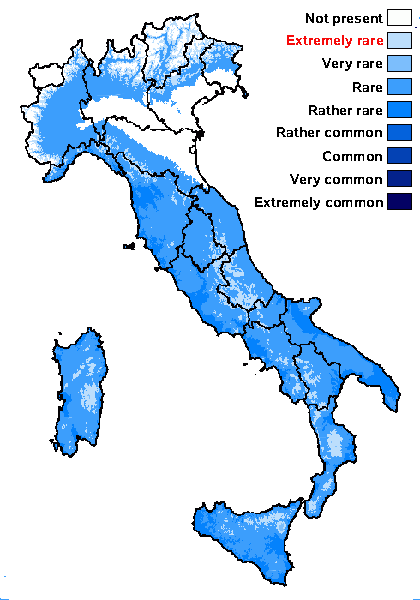
Predictive model
Herbarium samples
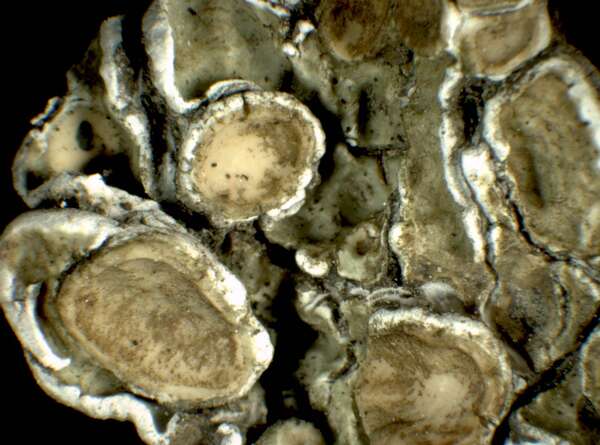

P.L. Nimis; Owner: Department of Life Sciences, University of Trieste
Herbarium: TSB (31676)
2001/12/11


P.L. Nimis; Owner: Department of Life Sciences, University of Trieste
Herbarium: TSB (31676)
2001/12/11
apothecium
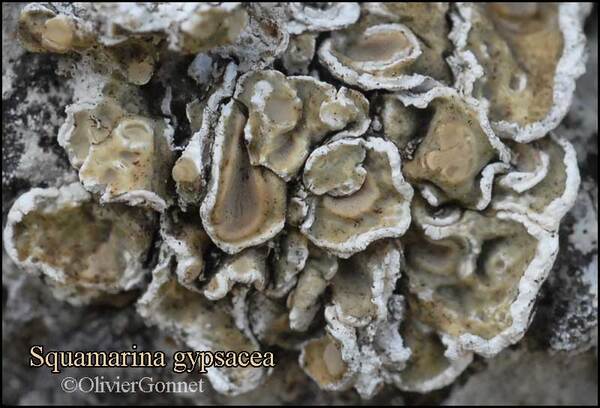
Courtesy Danièle et Olivier Gonnet - Source: https://www.afl-lichenologie.fr/Photos_AFL/Photos_AFL_S/Squamarina_gypsacea.htm
France, fisures de rochers - session AFL 2010 - Hérault - 34)
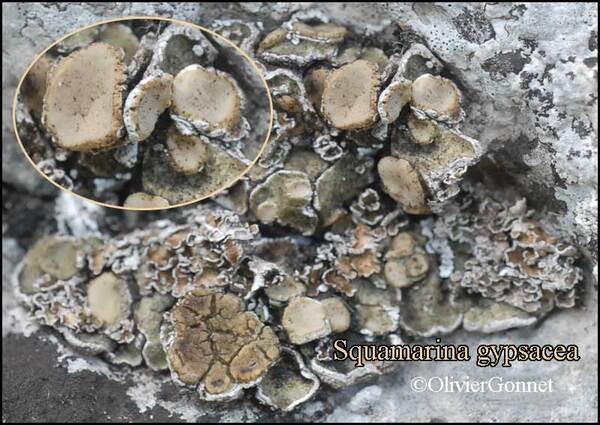
Courtesy Danièle et Olivier Gonnet - Source: https://www.afl-lichenologie.fr/Photos_AFL/Photos_AFL_S/Squamarina_gypsacea.htm
France, fisures de rochers - session AFL 2010 - Hérault - 34)
Growth form: Squamulose
Substrata: rocks
Photobiont: green algae other than Trentepohlia
Reproductive strategy: mainly sexual
Subcontinental: restricted to areas with a dry-subcontinental climate (e.g. dry Alpine valleys, parts of Mediterranean Italy)
paras Romjularia lurida
Commonnes-rarity: (info)
Alpine belt: absent
Subalpine belt: absent
Oromediterranean belt: very rare
Montane belt: extremely rare
Submediterranean belt: rare
Padanian area: absent
Humid submediterranean belt: rare
Humid mediterranean belt: rather rare
Dry mediterranean belt: rather rare

Predictive model
| Herbarium samples |


P.L. Nimis; Owner: Department of Life Sciences, University of Trieste
Herbarium: TSB (31676)
2001/12/11


P.L. Nimis; Owner: Department of Life Sciences, University of Trieste
Herbarium: TSB (31676)
2001/12/11
apothecium

Courtesy Danièle et Olivier Gonnet - Source: https://www.afl-lichenologie.fr/Photos_AFL/Photos_AFL_S/Squamarina_gypsacea.htm
France, fisures de rochers - session AFL 2010 - Hérault - 34)

 INDEX FUNGORUM
INDEX FUNGORUM
 GBIF
GBIF
 DOLICHENS
DOLICHENS



